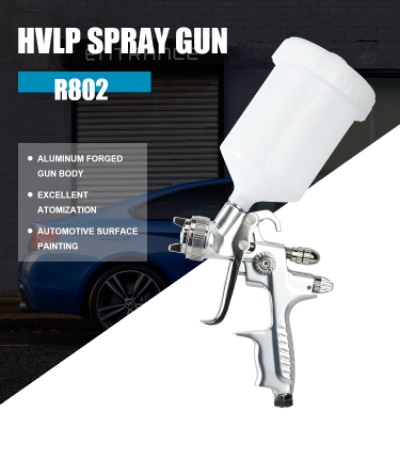

What's the difference between the right spray job and car refinish job with Rongpeng spray gun and a DIY disaster requires research, planning, and preparation. Use our car refinish car painting guide to apply a shiny new paint to your car and get a new lease of life!
What do you need for car refinish?
In order to paint your vehicle correctly, you will need some important materials:
Power sanding machine
Sanding pad
Air compressor
Paint sprayer
1200 and 2000 grit sandpaper
Cleaning solvent
newspaper
Masking tape
Primer
Enamel, acrylic enamel or polyurethane paint
Paint thinner
Facial mask
Goggles
Primer/primer
Varnish
A piece of rag
Denatured alcohol or mineral spirits
Friction compound (optional)
ready
Don’t rush to do the proper paint job-painting the vehicle takes a lot of time, so make sure you have a few days to get the job done.
Step 1: Choose your location wisely
Before starting any actual painting, you need to find a suitable location for your DIY project. Make sure that your location has enough space for you to work around the car, and that it is well ventilated and well lit. Choose a place with electricity and the least amount of dust. Avoid residential garages because these garages usually have stoves or heaters that can cause fires when they come in contact with paint fumes.
Step 2: Remove rust, dents and trim
Make sure your paint job does not aggravate any defects-repair any visible dents, repair all rust, and remove chrome or plastic trim. The decorative strips and decorative strips can be replaced after painting.
Polished
Step 3: Sanding
Make your paint smooth and adhere to its surface-use a sanding method to sand the entire vehicle, or until the bare metal, the original primer, or at least new paint.
If time is short, the third option is sufficient-but, from sanding to bare metal, you will get the best results.
Step 4: Clean
Use a rag and denatured alcohol or mineral oil to thoroughly wipe all surfaces of the vehicle to remove all oil and prepare for painting.
Step 5: Tape surface
Use tape and newspaper to cover vehicle surfaces that do not need to be painted, including mirrors, window trims, glass, grilles, and door handles.
Primer
Step 6: Perfusion
If you sand the car to bare metal, you need to use a corrosion-resistant and self-etching primer to prime the surface of the car.
Step 7: Let the primer cure
If any rust is removed, make sure to properly prime them with feather hair until they become smooth and apply enough primer on the area. Follow the instructions on the container to thoroughly cure all primers.
Step 8: Polish again
Sand the newly primed surface again, but make sure not to sand too much and expose the metal surface again.
Step 9: Wipe
Wipe the primed surface with a cloth dipped in thinner.
painting
When preparing to paint, be sure to follow the manufacturer's instructions and prepare the paint to be sprayed.
Step 10: Paint
Hold the spray gun about 6 inches away from the surface of the vehicle and sweep it left and right to spray paint on the thin and even coating. Generally, three to four layers will be required to completely cover the surface. Be sure to follow the manufacturer's drying time-this may vary from 20 minutes to an hour.
Step 11: Wipe
Before applying the last layer, sand the surface again to remove the powdery residue, and then wipe it with a clean cloth.
Step 12: Apply varnish
Use the same painting technique to apply a clear varnish.
Step 13: Remove the tape
While the clear coat is still wet, remove the masking tape, and then dry the clear coat according to the manufacturer's requirements.